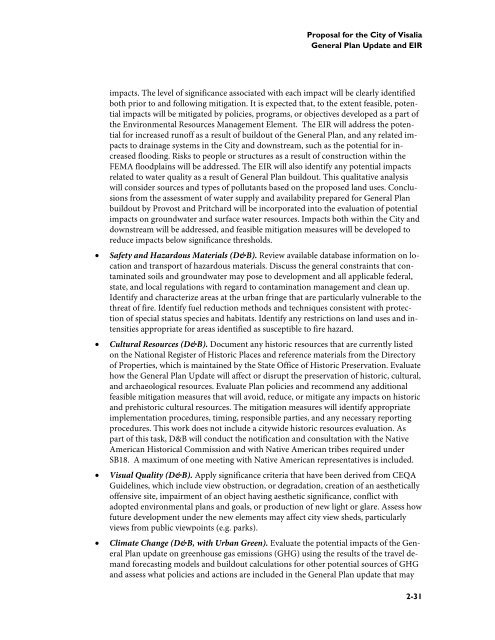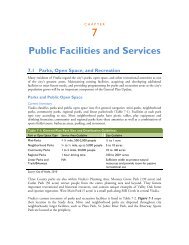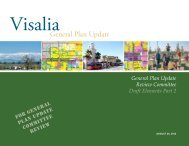Notice of Preparation - Visalia General Plan Update
Notice of Preparation - Visalia General Plan Update
Notice of Preparation - Visalia General Plan Update
Create successful ePaper yourself
Turn your PDF publications into a flip-book with our unique Google optimized e-Paper software.
Proposal for the City <strong>of</strong> <strong>Visalia</strong><br />
<strong>General</strong> <strong>Plan</strong> <strong>Update</strong> and EIR<br />
impacts. The level <strong>of</strong> significance associated with each impact will be clearly identified<br />
both prior to and following mitigation. It is expected that, to the extent feasible, potential<br />
impacts will be mitigated by policies, programs, or objectives developed as a part <strong>of</strong><br />
the Environmental Resources Management Element. The EIR will address the potential<br />
for increased run<strong>of</strong>f as a result <strong>of</strong> buildout <strong>of</strong> the <strong>General</strong> <strong>Plan</strong>, and any related impacts<br />
to drainage systems in the City and downstream, such as the potential for increased<br />
flooding. Risks to people or structures as a result <strong>of</strong> construction within the<br />
FEMA floodplains will be addressed. The EIR will also identify any potential impacts<br />
related to water quality as a result <strong>of</strong> <strong>General</strong> <strong>Plan</strong> buildout. This qualitative analysis<br />
will consider sources and types <strong>of</strong> pollutants based on the proposed land uses. Conclusions<br />
from the assessment <strong>of</strong> water supply and availability prepared for <strong>General</strong> <strong>Plan</strong><br />
buildout by Provost and Pritchard will be incorporated into the evaluation <strong>of</strong> potential<br />
impacts on groundwater and surface water resources. Impacts both within the City and<br />
downstream will be addressed, and feasible mitigation measures will be developed to<br />
reduce impacts below significance thresholds.<br />
• Safety and Hazardous Materials (D&B). Review available database information on location<br />
and transport <strong>of</strong> hazardous materials. Discuss the general constraints that contaminated<br />
soils and groundwater may pose to development and all applicable federal,<br />
state, and local regulations with regard to contamination management and clean up.<br />
Identify and characterize areas at the urban fringe that are particularly vulnerable to the<br />
threat <strong>of</strong> fire. Identify fuel reduction methods and techniques consistent with protection<br />
<strong>of</strong> special status species and habitats. Identify any restrictions on land uses and intensities<br />
appropriate for areas identified as susceptible to fire hazard.<br />
• Cultural Resources (D&B). Document any historic resources that are currently listed<br />
on the National Register <strong>of</strong> Historic Places and reference materials from the Directory<br />
<strong>of</strong> Properties, which is maintained by the State Office <strong>of</strong> Historic Preservation. Evaluate<br />
how the <strong>General</strong> <strong>Plan</strong> <strong>Update</strong> will affect or disrupt the preservation <strong>of</strong> historic, cultural,<br />
and archaeological resources. Evaluate <strong>Plan</strong> policies and recommend any additional<br />
feasible mitigation measures that will avoid, reduce, or mitigate any impacts on historic<br />
and prehistoric cultural resources. The mitigation measures will identify appropriate<br />
implementation procedures, timing, responsible parties, and any necessary reporting<br />
procedures. This work does not include a citywide historic resources evaluation. As<br />
part <strong>of</strong> this task, D&B will conduct the notification and consultation with the Native<br />
American Historical Commission and with Native American tribes required under<br />
SB18. A maximum <strong>of</strong> one meeting with Native American representatives is included.<br />
• Visual Quality (D&B). Apply significance criteria that have been derived from CEQA<br />
Guidelines, which include view obstruction, or degradation, creation <strong>of</strong> an aesthetically<br />
<strong>of</strong>fensive site, impairment <strong>of</strong> an object having aesthetic significance, conflict with<br />
adopted environmental plans and goals, or production <strong>of</strong> new light or glare. Assess how<br />
future development under the new elements may affect city view sheds, particularly<br />
views from public viewpoints (e.g. parks).<br />
• Climate Change (D&B, with Urban Green). Evaluate the potential impacts <strong>of</strong> the <strong>General</strong><br />
<strong>Plan</strong> update on greenhouse gas emissions (GHG) using the results <strong>of</strong> the travel demand<br />
forecasting models and buildout calculations for other potential sources <strong>of</strong> GHG<br />
and assess what policies and actions are included in the <strong>General</strong> <strong>Plan</strong> update that may<br />
2-31




